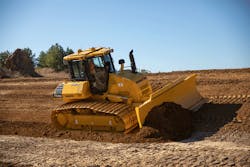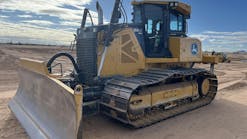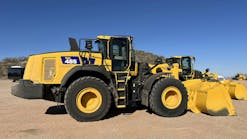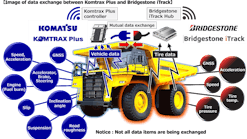Komatsu has introduced the D71EX-24 and D71PX-24 crawler dozers, hydrostatic models designed for grading, pushing, side-cutting, and work on soft ground, making it capable of both production and finishing tasks.
Weighing in between 49,824 and 50,927 pounds depending on configuration, Komatsu's largest hydrostatic dozer generates 237 horsepower. Operators can maintain ground speed while operating under heavy loads by using the machine’s H mode.
A distinctive slant nose design offers visibility to the cutting edges, as well as additional balance and maneuverability.
The unit is equally adept at precise, high-speed grading and rough dozing, the company says, and is designed to provide wearability and functionality with a high-capacity, wear-resistant dozer blade.
The Komatsu D71EX-24 dozer’s Parallel Link Undercarriage System (PLUS) features rotating bushings to help minimize maintenance downtime and cost of ownership.
It is also available with Komatsu’s latest intelligent Machine Control (iMC) 2.0 capabilities, inclucing lift layer control, tilt steering control, the ability to create a temporary design surface, and proactive dozer control.
Lift layer control optimizes earthwork productivity with the press of a button, according to Komatsu. It maintains compaction quality by automatically controlling lifts to the desired height. Excess fill is eliminated as automatic blade control follows the finish surface once lifts have reached finished grade.
Tilt steering control automatically tilts the blade to maintain straight travel during rough dozing. It can reduce operator steering input by up to 80 percent.
Operators can create a temporary design surface with the press of a button with quick surface creation. Combined with other iMC 2.0 functions, crews can begin stripping or spreading using automated input while waiting for the finish grade model.
Proactive dozing control is designed so that less experienced operators can automatically cut/strip from existing terrain. The dozer measures the terrain it tracks over and uses that data to plan the next pass, improving productivity by up to 60 percent versus previous generation machines.





